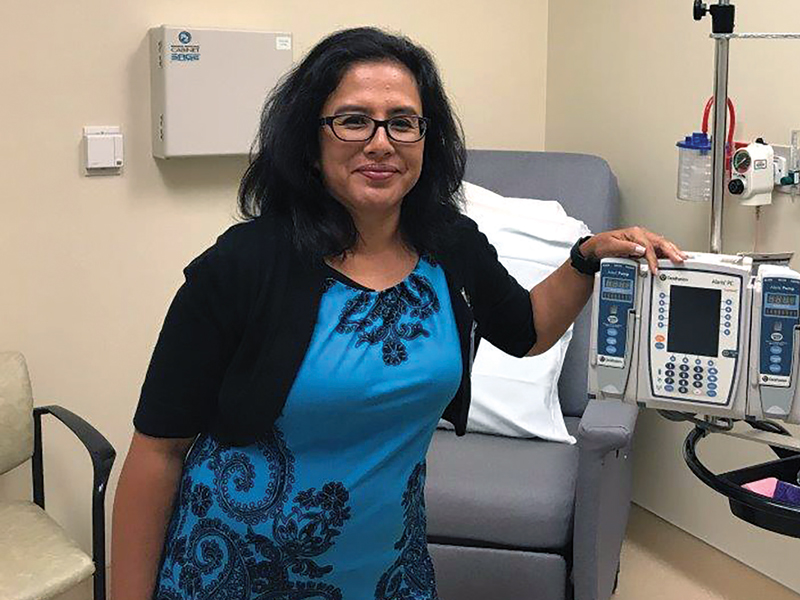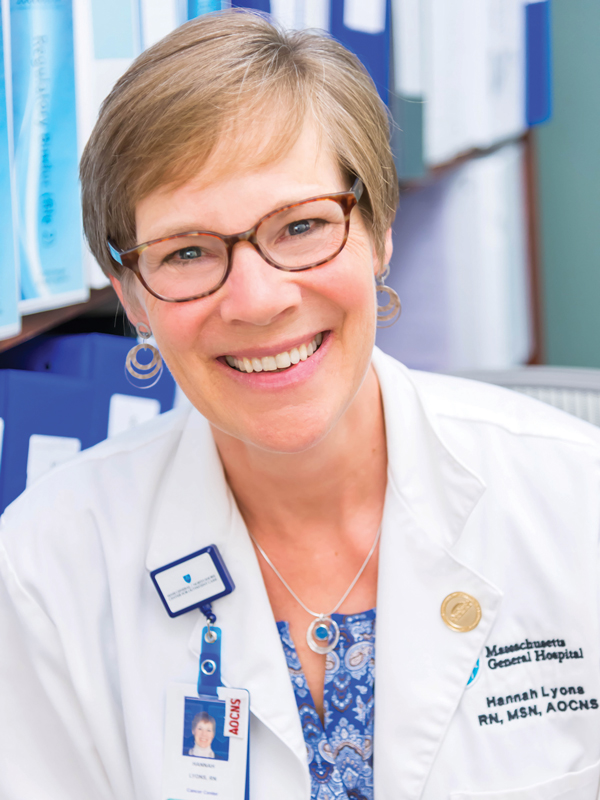Oncology Nurses Drive Change In Cancer Care With Clinical Trials
Clinical trials are responsible for discovering new treatments for cancer as well as the continued evolution of standards of care in clinical practice.
Nationally, less than 5% of all eligible adult patients with cancer enroll in clinical trials. Additionally, it takes a drug an average of six to eight years (https://www.cancer.org/treatment/treatments-and-side-effects/clinical-trials/what-you-need-to-know/clinical-trial-basics.html) from when it is first introduced in trials to become fully available to all patients who could benefit from it.
As part of a larger team of medical professionals, oncology nurses work to make trials appropriate and safe for patients while also providing them with access to groundbreaking new therapies. Oncology clinical trial nurses act as care providers, patient educators, team liaisons, research scientists, and leaders in clinical trials across a variety of settings.

Why Recruitment for Clinical Trials Isn’t Easy
One of the key steps to any clinical trial is finding patients who are eligible candidates. Recruitment for clinical trials is not as simple as signing a consent form and becoming part of the trial. It requires in-depth communication between care providers and prospective participants. Oncology nurses work to ensure physicians are aware of the trials available to patients, assist with screening for eligible patients, and help patients fully understand the intricacies of participating in a trial.
ONS member Kristine Abueg, RN, MSN, OCN®, CBCN®, clinical research nurse at Kaiser Permanente in Roseville, CA, has systems to address the challenge of aligning potential candidates with the clinical trials from which they’d benefit.
“At our institution, we have a multiple-prong approach to recruitment depending on the nature of the trial. In all cases, we leverage the power of our electronic medical record to identify patients early and communicate potential eligibility to physicians,” Abueg says. “That communication is not limited to medical and radiation oncologists, but we try to collaborate with referring specialists as well—urologists, surgeons, head and neck doctors, etc. We also have a very well-maintained internal website with descriptions and links to our current trials.”
Recruitment to clinical trials faces two big challenges: identifying patients for the trials, and reaching out to those patients. Although that may sound simple, recruitment must account for criteria that are specific to each trial: disease type, stage, performance status, and a litany of other factors. Not all patients are going to have the exact types of cancer that align with clinical trials offered in an institution or setting.
Matching Patients to the Right Trial
ONS member Hannah Lyons, RN, MSN, AOCNS®, research nurse manager for the cancer center satellites at Massachusetts General Hospital in Boston, recognizes the importance of identifying clinical trials that are appropriate for each institution’s patient population and setting.

“An important component of clinical trials recruitment is recognizing the needs of your location and patient population,” Lyons says. “If, in my community setting, I see a lot of patients with non-small cell lung cancer but only a few of those have ALK and EGFR mutations targets, I’m not going to open a clinical trial that’s specific for ALK and EGFR. I would open trials that are more generic to patients with non-small cell lung cancer. Identifying patient populations to target for clinical trials in the community setting involves working with healthcare providers from different teams, like the tumor registrar, nurse practitioners, and physicians. This collaboration helps us understand broadly how many potential candidates are seen annually with specific disease types.”
For Abueg, part of her role requires identifying the right patients for the right trials, like fitting together the pieces of an ever-changing and evolving jigsaw puzzle. She’ll work to examine a patient’s present information and medical history to ensure the right clinical trial is offered.
“As a research nurse, I evaluate all new consults for clinical trial eligibility—I review their pathology, past medical history, and imaging, and I discuss clinical trial options with the physician,” Abueg notes. “For the survivorship and cancer control studies, we are able to conduct a search of our entire Northern California electronic patient database for key eligibility factors. Patients are then contacted first via postcard to assess initial interest. If they would like additional information, the pertinent staff initiate telephone contact.”
It’s a difficult but worthwhile process to recruit patients. Meeting the exact specifications for a clinical trial is crucial to the accuracy of the results. Ensuring that patients have found the right trial for them and are receiving the best options for their disease is just the beginning.
Keeping Patients With Cancer Front and Center
Once the hurdles of identification and recruitment are overcome, it’s essential that patients are debriefed regarding the intricacies of their clinical trial. Their consent is paramount to the entire process. According to Abueg, it’s always a good thing when patients start asking questions.
“I’ve conducted two-hour meetings with patients while they literally go through single-spaced, double sided pages of questions they’ve prepared. It’s time consuming, sure, but I frequently tell patients that I’m much happier to see lots of scrutiny and questions than the ‘I’ll do whatever you guys tell me to do’ response,” she says. Patient education can’t be understated.
Lyons notes the importance of helping patients to understand what it means to participate in a clinical trial. “It’s crucial—patient education is absolutely crucial. The physicians review the consent and discuss the scientific rationale for the trial. They focus on the ‘why’ with patients. I get to meet with patients and talk about what it’s like to live with the trial,” she says. “I talk about the procedures that are required, and we go through the consent forms again. An example of requirements may be pharmacokinetic studies that are needed at precise times before or after the study drugs are administered. I talk to our patients about how we can manage the specific requirements of the trial with minimal impact on their lives.”
Clinical Efficiency Is Key to Success
In Abueg’s and Lyons’ experience, the more educated and informed patients are, the more likely they are to embrace the study and ensure its validity.
“More informed patients are more compliant with the trial requirements, because they aren’t taken off guard,” Abueg says. “More education also engenders more trust, which is true of all nursing. This is particularly critical in research where I need patients to tell me all of their symptoms immediately. Our patients are our partners in this endeavor. We—the research team—base our reporting of symptoms 100% on the patient experience. We can only do that effectively with an informed patient.
“Research protocols require a great deal of adherence to the details outlined by the trial. If the trial says to infuse a drug over 30 minutes plus or minus 5 minutes, or to obtain vital signs within 15 minutes prior to infusion, or to infuse drug A then drug B—well, there’s absolutely no leeway in those parameters,” Abueg continues. “It’s critical that those directions are followed across the trial. It may sound nitpicky, but the drug package inserts—yes, including administration directions—are based solely on the clinical trial data that led to the drug’s approval. Consistency in administration across all patients is critical to ensure that we can identify potential risks and causes.”
Breaking Down Myths and Changing the Future
Although clinical trials are more understood by patients now, many potential candidates believe persistent myths that affect their decisions. Abueg says that many patients seem to think clinical trials are only last-resort options. Yet clinical trials span all stages of cancer. She also finds patients who are worried about receiving only a placebo in place of actual treatment.
“Many patients are very surprised that most trials don’t involve placebos,” Abueg says. “The RTOG 1010 study is a good example of this. The trial investigates the application of trastuzumab in esophageal adenocarcinoma. Patients are randomized to receive the standard of care or to receive maintenance trastuzumab for 13 weeks after surgery. There are no placebos.”
Lyons knows that clinical trials are changing the future of cancer treatments by introducing new medications and procedures to treat patients across the spectrum of disease. Key to this progress in cancer care are nurses who support their patients through the trials journey.
“Oncology nurses support their patients by working closely with the research team,” Lyons says. “The researchers can give you an understanding of the rationale for the trial and the potential side effects seen in previous studies. That way, when you’re treating patients, you’ll have an idea of the expected side effects, and you can help reinforce the potential positives to patients by alleviating any fears that they may have.”
Oncology nurses, nurse scientists, and the entire care team are working together to drive innovation in the treatment of cancer. Clinical trials don’t just offer new treatment options to families, loved ones, and patients with cancer—they provide hope to future generations yet to face their diagnoses.
